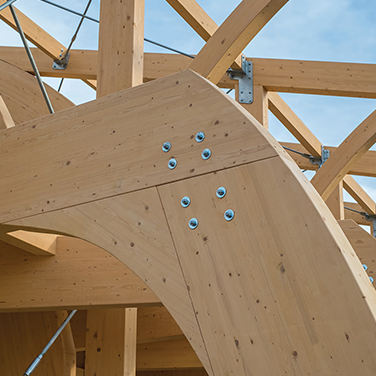Buildings Made of Timber Are Reaching New Heights
By Gina Wynn
Around the world, innovative builders are constructing with sustainability in mind by choosing wood as their main building material. And they are taking their structures to new heights.
Still the most popular building material in the U.S. for homes, standard lumber was replaced by steel as the go-to material for taller buildings in the mid-19th century. A light, durable metal, steel made it possible for buildings to stretch more than 40 or 50 stories into the clouds. Steel also didn’t go up in flames as easily as wood. Most big cities have experienced “great fires” throughout history that destroyed entire city blocks and have since put strict fire codes in place.
New and Improved Wood
For the type of mass timber that has been catching the attention of environmentally minded developers in recent years, susceptibility to fire has not been a problem. Known as cross-laminated timber (CLT), it is made up of several layers of lumber boards bonded with adhesives and pressed to form single, solid rectangular panels. It is typically cut to the desired dimensions before being sent to construction sites where it is fastened to other pre-cut pieces like IKEA furniture. Europeans have found success with the material and have been building with it for nearly 30 years.
As for fire resistance, studies have shown that the technology is on par with other building materials. Tests of five-ply CLT panel walls resulted in the material lasting 3 hours and 6 minutes after being subjected to temperatures exceeding 1,800 degrees Fahrenheit, according to Think Wood. That far exceeds the two-hour rating required by building codes.
A Sustainable Alternative
CLT is also a more sustainable building material. It can be made from sawmill scraps or newly harvested lumber of any age and size and still be as strong as steel. In addition, the pieces required for building can be prefabricated in factories instead of being prepared at the building site. This makes construction go faster and reduces truck traffic and the need for road closures.
Also, the process for creating CLT requires much less energy than steel production (which involves melting rocks) and results in fewer carbon dioxide emissions. Steel manufacturing accounts for around seven percent of the world’s carbon dioxide emissions, according to Global Efficiency Intelligence.
Compared to building with concrete, the most widely used building material in the world, CLT usage results in an immediate 50 percent reduction in emissions according to Anna Ervast Oberg. A project manager with the Swedish firm Folkhem, she was interviewed by The New York Times about her company’s new CLT development, Cederhusen. She added that over the lifetime of a typical concrete building, roughly 70 percent of carbon emissions would result from the two-year construction period.
Another big benefit to CLT is that it sequesters the carbon that was absorbed before the trees were harvested for lumber. That carbon will remain trapped in the CLT in the walls of buildings for the foreseeable future — and will not be released back into the Earth’s atmosphere.
"Another big benefit to CLT is that it sequesters the carbon that was absorbed before the trees were harvested for lumber."
The Wooden Building Boom
Developers worldwide are taking note of these environmental benefits. In Austria — a pioneer in the timber revolution — they used CLT to construct the 24-story HoHo Vienna high-rise that extends nearly 276 feet above northeast Vienna. It houses a hotel, restaurant, wellness center, and offices.
With forests as its main natural resource, Austria has regulations in place that protect valuable forested areas. They help forest managers ensure that after logging each year, over 141 million cubic feet of trees remain in the forest, continually increasing timber stocks. This means that over 35 cubic feet of wood grows back every second and the timber used for the entire HoHo Vienna project will have grown back in only one hour and 17 minutes, according to Housing Evolutions by Housing Europe.
International Competition
Across the pond, another wooden skyscraper is scheduled for completion in 2022 in Milwaukee. The high-end apartment complex will reach 25 stories and stand 284 feet, overtaking the Mjøstårnet (280 feet) in Norway as the tallest timber tower. Developers of the Milwaukee project claim it will offset the equivalent of carbon dioxide produced by 2,500 cars or enough energy to power 1,200 homes per year.
As of June 2021, 1,169 multi-family, commercial, or institutional mass timber projects had been completed or were being designed in all 50 of the United States.
Other non-U.S. locations already reaping the environmental benefits of mass timber buildings include Finland and British Columbia, and designs have been proposed for the Netherlands and London. In collaboration with University of Cambridge researchers, architects and engineers hope to construct an 80-story, one-million-square-foot skyscraper that would stand 984 feet tall at the Barbican. If completed, it would become the world’s 18th tallest building, surpassing Four World Trade Center in New York City.
It’s no wonder the construction industry has become enamored with CLT. Among other advantages, CLT adds less carbon dioxide to the atmosphere, enables faster construction, causes less disruption to cities, and cuts labor costs. The stronger, dense material also makes buildings lighter, which means they can continue climbing higher. Whether the world’s lumber supply can keep up with demand remains to be seen. If it can, only the sky is the limit to wooden skyscraper innovation.
This content was inspired, in part, by “4 Things to Know About Mass Timber,” Think Wood; “Milwaukee Is On Track To House World’s Tallest Timber Skyscraper,” NPR, December 7, 2020; “Will the skyscrapers of the future be made out of wood?” National Geographic, January 13, 2020; and “Wooden Buildings Reach for the Sky,” The New York Times.
Gina Wynn is a Thermo Fisher Scientific staff writer.
